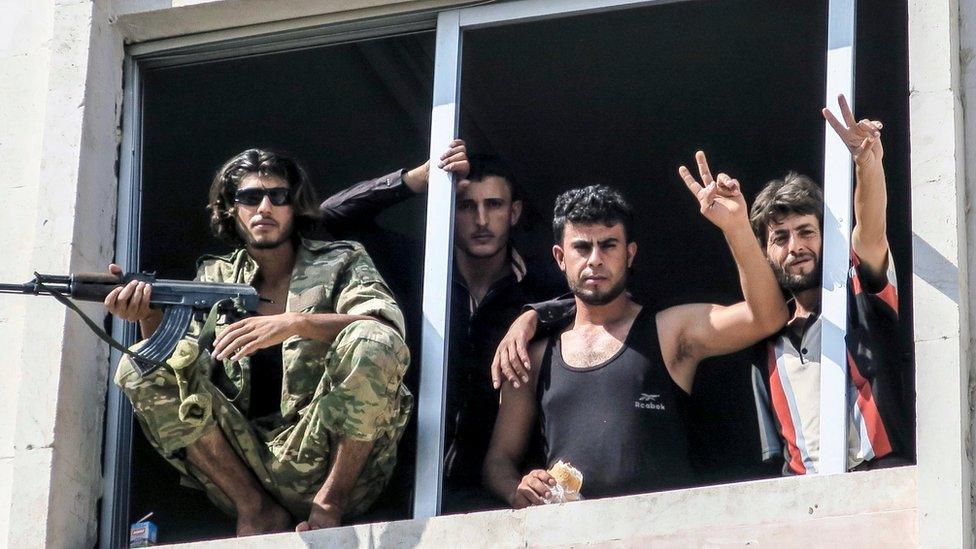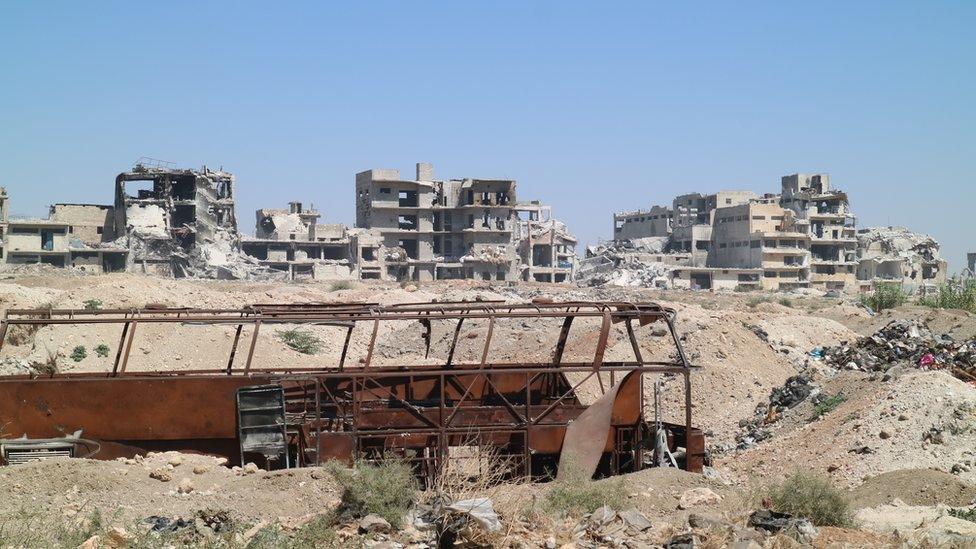Syria ceasefire: 'No civilian deaths on first day'
- Published

Monitors said fighting had largely stopped, with no civilian deaths recorded in the first 15 hours
The cessation of hostilities in Syria that came into effect at sunset on Monday is largely holding on its first full day, reports suggest.
UK-based monitoring group the Syrian Observatory for Human Rights said it had recorded no civilian deaths in the first 15 hours of the truce.
Residents in the embattled northern city of Aleppo reported calm.
UN officials say they are ready to deliver aid to besieged areas but need better guarantees of peace.
The Syrian government says it will not allow aid, particularly "from the Turkish regime", to be delivered to Aleppo without prior co-ordination with it and the UN, state media report.
Some 250,000 civilians are estimated to be trapped in the rebel-held eastern part of Aleppo due to a siege by government forces.
'Sporadic attacks'
The fledgling truce was reportedly broken by sporadic attacks late on Monday, carried out by both government forces and rebels after the ceasefire had come into effect.
The Syrian Observatory said it had seen reports of aerial bombardment of some villages in Hama province, and shelling near Damascus.
The Syrian army has said the truce will be applied throughout Syria for seven days, but that it reserves the right to respond decisively to any violation by armed groups.
A number of rebel factions have given a guarded welcome to the deal but expressed reservations about its implementation.

Families have returned to safer parts of Aleppo, but many to badly damaged homes
Humanitarian groups are hoping to make aid deliveries to the worst-hit areas, especially Aleppo.
A UN spokesman said aid convoys were ready to travel in from Turkey but officials needed to see "a laying down of weapons that satisfies us... and as I speak that has not yet been the case".
Russian news agency Tass said that Russian troops had secured part of Castello Road - a key access route into Aleppo - on Tuesday, although this has not been confirmed.
US Secretary of State John Kerry called on Friday for the road to be demilitarised and said the US would work with Russia to free the route for aid convoys.

Entire districts of the city of Homs have been abandoned
The deal, described by Mr Kerry as the "last chance to save a united Syria", was struck on Friday in Geneva after months of talks between Russia and the US. It requires both sides to allow unhindered access for humanitarian aid.
If the truce holds for seven days, the US and Russia will carry out co-ordinated air strikes on militant groups - including so-called Islamic State and Jabhat Fateh al-Sham (known until recently as the Nusra Front).
The opposition Free Syrian Army group has said that while it will "co-operate positively" with the ceasefire, it was concerned it would benefit the government.

The road to Aleppo, recently recaptured by the Syrian army, saw heavy fighting
Another major rebel group, the hardline Islamist Ahrar al-Sham, initially rejected the deal but later appeared to have softened its stance.
Opposition sources quoted by Reuters said a forthcoming statement supporting the cessation "with harsh reservations" would be backed by "the largest groups", including Ahrar al-Sham.
Speaking earlier, President Bashar al-Assad welcomed the deal but said the Syrian state was still "determined to recover every area from the terrorists, and to rebuild".
President Bashar al-Assad: "The Syrian state is determined to recover all areas from the terrorists"
The number of deaths recorded since the beginning of the conflict in March 2011 has now risen past 300,000, according to the Syrian Observatory for Human Rights.
However, it said it estimated the full death toll to be about 430,000.
The official UN estimate rests at 250,000 after the organisation stopped counting in 2014, uncertain of its ability to gather accurate data.
More than 4.8 million have fled abroad, and an estimated 6.5 million others have been displaced within the country, the UN says.

Areas of control around Aleppo


Big test for US and Russia: BBC Middle East editor Jeremy Bowen
The strength, or otherwise, of the ceasefire is a big test of what appears to be a less sour, more workable relationship between the foreign ministers of the US and Russia.
Diplomacy failed in the first, critical years of the war. A major reason for that was diplomatic deadlock between President Bashar al-Assad's ally, Russia, and the US, which demanded his immediate departure from office.
Since then Russia has become the most influential outside power in Syria. The US and its Western allies have struggled to keep up.
Perhaps Moscow is now ready to build on a ceasefire, if it lasts, to push President Assad towards a political transition that might end the war.
Or perhaps, as enemies of President Assad and the Russians believe, the ceasefire will be a chance to regroup and rearm.

If the truce holds...

Government forces have regained ground in Aleppo
Jihadist groups like so-called Islamic State and Jabhat Fateh al-Sham face the joint might of the Russian and US air forces
Moderate rebels and civilians in the areas they hold will no longer face the threat of indiscriminate air strikes such as barrel-bombing although the Syrian air force will not be grounded completely; aid deliveries will be allowed to areas currently under siege
President Assad will be in a stronger position as the US and Russia engage two of his most effective military opponents while moderate rebels observe the truce with his forces

Syria's history of failed deals

Can Kerry (left) and Lavrov succeed at last?
February 2012: Syrian government "categorically rejects" an Arab League plan calling for a joint Arab-UN peacekeeping mission
June 2012/January 2014/January 2016: Three failed UN-sponsored peace conferences in Geneva
September 2013: Kerry and Lavrov negotiate a deal to strip the Syrian government of its chemical weapons in return for the US backing away from air strikes. Since then, the government has again and repeatedly been accused of using toxic chemicals against rebel-held areas
February 2016: World powers agree in Munich on a nationwide "cessation of hostilities" in Syria excluding jihadist groups. There is no agreement on any joint US-Russian operations. The "pause" quickly unravels as Assad promises to regain control of the whole country
March 2016: President Vladimir Putin declares "mission accomplished" in Syria and orders removal of "main part" of Russia's air army in Syria. Russian air strikes have continued ever since